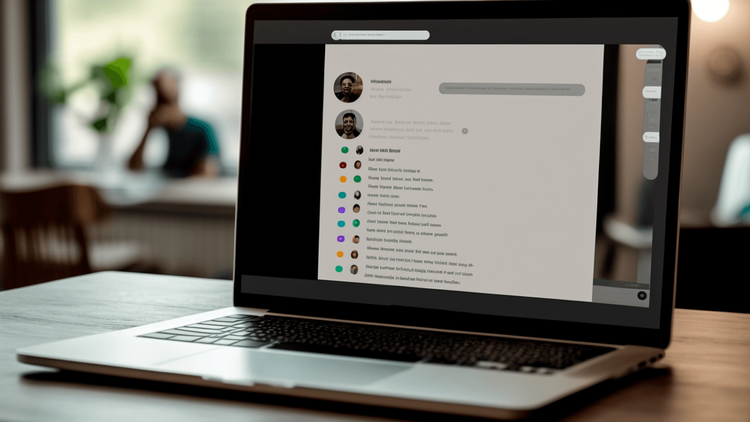Slack Etiquette for New Sales Reps
Many are new to the world of Slack and instant-messaging when they join the corporate world. Get introduced to slack etiquette at work!

Aug 23, 2022
Congratulations on your new sales career! As you progress through sales training, sales internships, jobs as a sales development rep, and other new roles, you’re going to have a lot of amazing experiences and a lot of fun.
But starting a new career also means learning a new culture. If you’ve landed on this page, it’s probably because you’re being introduced to Slack for the first time. Or maybe it’s because you’ve realized (or someone else has pointed out!) that the way you interact on Slack can sometimes rub people the wrong way. Either way, you’ve come to the right place!
What is Slack?
Slack is the leading instant messenger for growing tech companies. But it’s also used by businesses small and large in many other industries,including 65% of the Fortune 100.
Slack isn’t the only tool that operates in this space. Other similar systems include Microsoft Teams, Discord, Facebook Workplace, and Google Hangouts.
For companies with many employees in different locations, or a lot of people who work from home, Slack is a virtual replacement for their office space. It’s where employees go to chit-chat, where managers go to see who is showing up to work, and where executives check in on the pulse of the business. But for a new sales employee, Slack will inevitably be where you go to learn.
How do I access Slack?
Every company has a workspace” with a unique URL, likehttps://uvaro.slack.com. You can open that URL in your internet browser tologin to Slackfrom anywhere.
But Slack is designed to be easy to access. So most users will also download and install Slack on their computers, and add the mobile app to their phone, too.
This ease of communication is both a blessing and a curse: It means that while it’s always easy for you to access work, it’s also always easy for work to access you. So be respectful of other users and their free time, and hopefully they’ll be respectful of you, too.
Why use Slack?
You may be wondering why companies choose to use Slack over other communication channels:
- What’s wrong with email?
- What happened to picking up the phone?
- Why can’t I just send my boss a text message?
None of these other modes of communication have gone away. But Slack combines secure access control, record keeping, and immediacy in a way that no other tool can.
With Slack, an IT Manager can instantly provision accounts for new employees, and instantly revoke access on a worker’s last day. Auditors can access all of the communications taking place within a business, going back to the dawn of time.” And employees can search these users and histories to quickly find answers to their questions.
What’s the Difference Between Slack and Email?
Slack and email have many similarities. Both allow you to attach documents, communicate virtually, and share information with multiple people.
Anyone can send an email to anybody else. But Slack is different because it’s a closed system. Only pre-approved users can send messages in your company’s Slack workspace.
Slack is also organized from the top-down. So whereas you can organize the folders in your email inbox however you want, someone in company management is largely responsible for organizing Slack’s differentchannels.
But it's still a modern web tool and an instant messenger, so Slack cuts down on a lot of workplace formality, and adds a lot of automations. On Slack, you don’t need to put a lot of effort into greetings and signatures—just get to the point!
Because Slack was only released in 2013, the norms of behavior when using it are still evolving. If companies have rules about what’s appropriate, they’re probably universal, as opposed to platform-specific.
You probably already know to treat others with respect, keep controversial opinions to yourself, andnot toslack offon the job. So in this article, we’ll teach you some of the unwritten rules of Slack, and help you learn how to fit in at work—and how to stand out, too!
Direct Messages
First up, let’s talk about Direct Messages, otherwise known as DMs. (Have you been saying PM? That’s very 2003.)
DMs are a mostly private way of communicating with other individuals. They’re perfect for coordinating one-on-one meetings, collaborating on very tedious tasks, and handling ultra-sensitive information.
While DMs seem non-invasive and unobtrusive, outside of the above specific situations, a DM is rarely the best message to send. Keep in mind why Slack is so incredibly useful: Fast responses and record-keeping. Fortunately, we have channels for that.
When you set up your Slack account, you’ll be prompted to include aprofile with personal informationabout yourself, like your name and photo. We recommend using your full name, and a close-up photo of your face. Since Slack is where much of your workday takes place, this is how your managers and coworkers will see and interact with you. Don’t be shy!
#Channels
Normally when you have a question, an answer, or an informational tidbit, it’s meaningful to more than one other person. So Slack is organized into channels of related information.
Marked with a hashtag, channels are like the different stations on your TV: One for news, one for sports, one for nature documentaries, etc. You should help keep things organized by alwaysputting information into the correct channel.
Let’s say you have a question for the marketing team. Don’t send an email to the VP of Marketing! And don’t post in the #general channel either. Instead, find the #marketing channel, and see if you can get an answer there.
Of course, you should also avoid joining every channel: The constant stream of information and notifications can quickly become overwhelming! If a channel isn't useful for you anymore, it's okay to leave.
Different companies organize their channels in different ways. So before you go off creating channels of your own, take a look around: There’s probably already one that suits your needs. And if there isn't, consider whether a DM is the temporary solution you need (or consider a group DM—you can DM more than one person at the same time).
A note on private channels: You may sometimes see Slack channels with locks on them. These private channels are only viewable with additional permission. They’re used for things like hiring processes, performance reviews, salary conversations, HR investigations, executive discussions, and or other sensitive information. If it’s none of your business, don’t go knocking!
Formatting
Slack is a different type of communication tool, so it calls for different types of formatting. You don’t need to introduce yourself every time you send a message. You already have a profile with your photo and full name. And these are the people you work with every day! So skip the fluff, and get to the good stuff.
In addition to workspaces (one per company) and channels (one for each topic), Slack is organized into threads. Every message you send to a channel can be converted into a thread. Because of this, it’s usually best to only include one idea per message.
Remember, the goal is to be brief! One quick question can get one quick answer. And ten quick questions can get ten quick answers. But a very long question—with sub-questions, meandering logic, and off-topic references—is also very hard to answer, and might just get ignored.
Being brief makes it easier for everyone to stay on task, and will make future searches for information a lot easier to manage, too. You can use:
1️⃣ emojis, 2️⃣bolding, 3️⃣italics, 4️⃣ line breaks, and other types of formatting tosplit up and organize your posts.
Emojis
Emojis can say a lot without actually using words. They’re light-hearted and easy to use, so it may seem strange to suggest leveraging them in a professional environment. But on Slack,emoji reactions save time and effort. Let’s say your manager asks if you received the update about a project. How do you reply?
- Yes I received it on Thursday, thank you for checking.”
- Yup!”
- 👍
The thumbs-up emoji saves you the effort of typing, saves your manager the effort of reading, gets the same point across, and avoids any accidental miscommunications.
Response Times
Working remotely doesn’t always mean working with flex-hours. There’s normally an expectation that during your team's normal business hours, your response time on Slack will be prompt.
So evenings and weekends notwithstanding, even if you can't usually reply within a few seconds, it’s stillnormally expectednot to make anyone wait for your reply on Slack for more than an hour or so.
If you’re in an internship or working on a project part-time, this can sometimes lead tofrustration—you may feel like your messages are constantly piling up, and full-time workers may feel like they can never get a timely answer out of you.
Your company probably doesn’t have a specific time frame in which you have to respond. But try to check in on your devices a few times throughout the day if you can. And if you do notice frustration building, work with your mentors to help manage expectations.
Searching
Search before you ask! Slack’s search tool is fast and comprehensive. It’s like Google for your entire company’s chat history. If you have a question, you can probably find the answer with search—even if the answer was written many years ago, in a channel you don’t use, by people you’ve never met.
If you want to resume a conversation from a long time back, clarify an old answer, or use an old message as a prompt for a new conversation, try sharing” the message. This makes it easy to start a new thread, while putting the historical context at everyone’s disposal.
@Tagging
In addition to getting someone’s attention with a DM, Slack allows you to@tagother users in channels.
This is a good way to make sure that someone (like your manager!) gets notified about a message you post. But because tagging someone also sends a notification to their mobile device, it’s also a way to quickly become annoying and unwanted.
So use tags sparingly, and be careful aboutwhenyou tag someone. Tagging people late at night can be extremely disruptive—and many senior-level managers can’t use the Do Not Disturb function, because they need to be available in case of emergencies.
Do Not Disturb
Do you like to sleep soundly through the night? Prefer to avoid awkward notifications in the middle of meetings? Then useDo Not Disturbtoset times in which Slack is unable to interrupt you.
Enough said. Are you ready to take Slack to the next level? Check out Kiite’sTop 10 Slack Apps for Sales.






